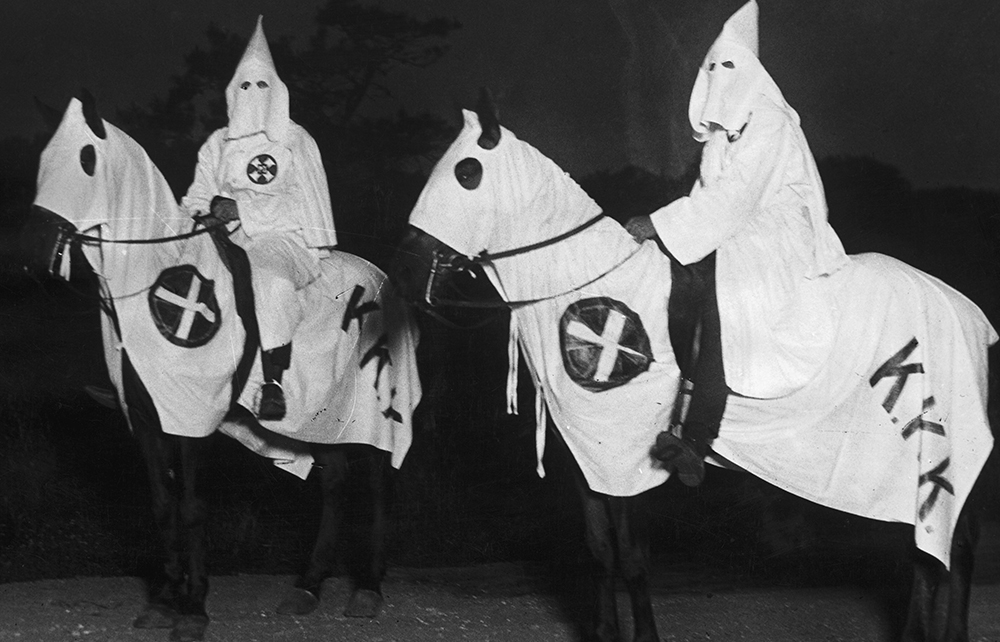This is the first history of the Ku Klux Klan from ‘its origins in post-Civil War Tennessee to the present day’ and it makes for a lively read. Kristofer Allerfeldt, a history professor at the University of Exeter, combines lucid political analysis with eye-popping details of violence. One victim of a lynching was made to climb a tree with a noose round his neck but stubbornly clung onto a branch. Rather than waste a bullet and spare him a slow death by strangulation, a Klan member climbed up after him and sawed off his fingers one by one until he dropped.
The Klan started as a fraternity of six young, former Confederate soldiers soon after the Civil War ended. Following the example of other fraternities, it adopted rituals, oaths, costumes and arcane titles such as ‘Grand Turk’ and ‘Grand Cyclops’, but it also had a more sinister association, as two of the men were appointed ‘Night Hawks’, a reference back to the patrols which had searched for runaway slaves in the antebellum South.

Between 1867 and 1869, the Klan became an insurgent army across the South and ‘quickly gained a reputation for being ubiquitous, omnipresent, omnipotent and ultra-violent’. The Reconstruction Acts had resulted in black legislators, magistrates, militias and Union Leagues. The Klansmen responded with acts of terror intended to suppress the black vote; but they also attacked white men who collaborated with the federal authorities, deeming them to be race traitors or ‘scalawags’.
In 1871, Congress passed the Ku Klux Klan Act, which made the Klan an illegal organisation; but of 3,000 men indicted a mere 65 were given short prison sentences. Thereafter, the Klan sought to burnish its myth as a chivalrous band of brothers that had resisted northern tyranny.
Inspired by D.W. Griffith’s The Birth of a Nation, the Klan was revived in Georgia in 1915 by the self-styled Imperial Wizard William Joseph Simmons, who engaged a local manufacturer to produce robes and hoods based on those used in the movie. Simmons had a knack for silly names using the letter ‘K’, such as ‘Kleagles’ and ‘Klonversations’, and even called the Klan’s new founding document the Kloran. Once America entered the European war in 1917, Klansmen were encouraged to snoop on neighbours with foreign-sounding names as part of a new nativist agenda, but it was only when a pair of unscrupulous grifters, Edward Young Clarke and Elizabeth Tyler, hired a 1,100-strong sales force paid on a commission basis that Klan membership began to surge in 1921.
New York newspapers vied with one another in running exposés of how the Klan was now targeting Jews and Catholics (the Pope was referred to as ‘the Tyrant on the Tiber’) and also of how it was ripping off its members by overcharging for costumes. Yet adverse press coverage and a Congressional investigation proved to be better than advertising. In 1922, the Klan was behind the election of 75 national congressmen and senators, and one historian has reckoned its membership reached 2.5 million in 1923. It was now focused on American ideals, and appealed to an increasingly affluent middle class that adored fraternities and regarded radicalism and foreigners as ever-present threats.
The Klan spread throughout northern states as blacks migrated there from the South (the black population of Detroit, for example, grew by 2,000 per cent), and by 1925, when it marched peacefully in Washington, it had a presence in every US state. Its rise, argues Allerfeldt, ‘often owed remarkably little to its stated ideologies, and far more to marketing’.
Some branches were more violent than others, Oklahoma being the worst. The Klan in Dallas, Texas, had a special ‘whipping meadow’ outside town. A Dallas hotel bellhop suspected of having sex with a white woman was kidnapped, given 30 lashes and had the letters ‘KKK’ etched on his forehead with silver nitrate. Such violence was too much for a would-be mainstream movement. The Klan ‘flared up, prospered and imploded with spectacular speed’, writes Allerfeldt, and an unsavoury parade of rogues and psychopaths marches through his story.
Just as the Internal Revenue Service put paid to Al Capone, so it moved against the Klan in 1944, presenting it with a bill for unpaid tax of $685,305. The Klan ceased to exist as a corporate entity and was replaced by new spin-off groups. In the 1970s, when anti-Klan activists began successfully suing Klan members for damages in the civil courts, membership dwindled to a few thousand.
The Klan’s last strength has been ‘the ability to disguise its diminishing physical numbers with a hyped online presence’, while it has adopted new victimhood narratives, such as abortion clinics being part of ‘the White Holocaust’. As the Klan has declined, so hate has become more diffuse, and although no Klan symbols were on display on 6 January 2021, says Allerfeldt, there were ‘echoes of the Klan all over that shameful event’.





Comments